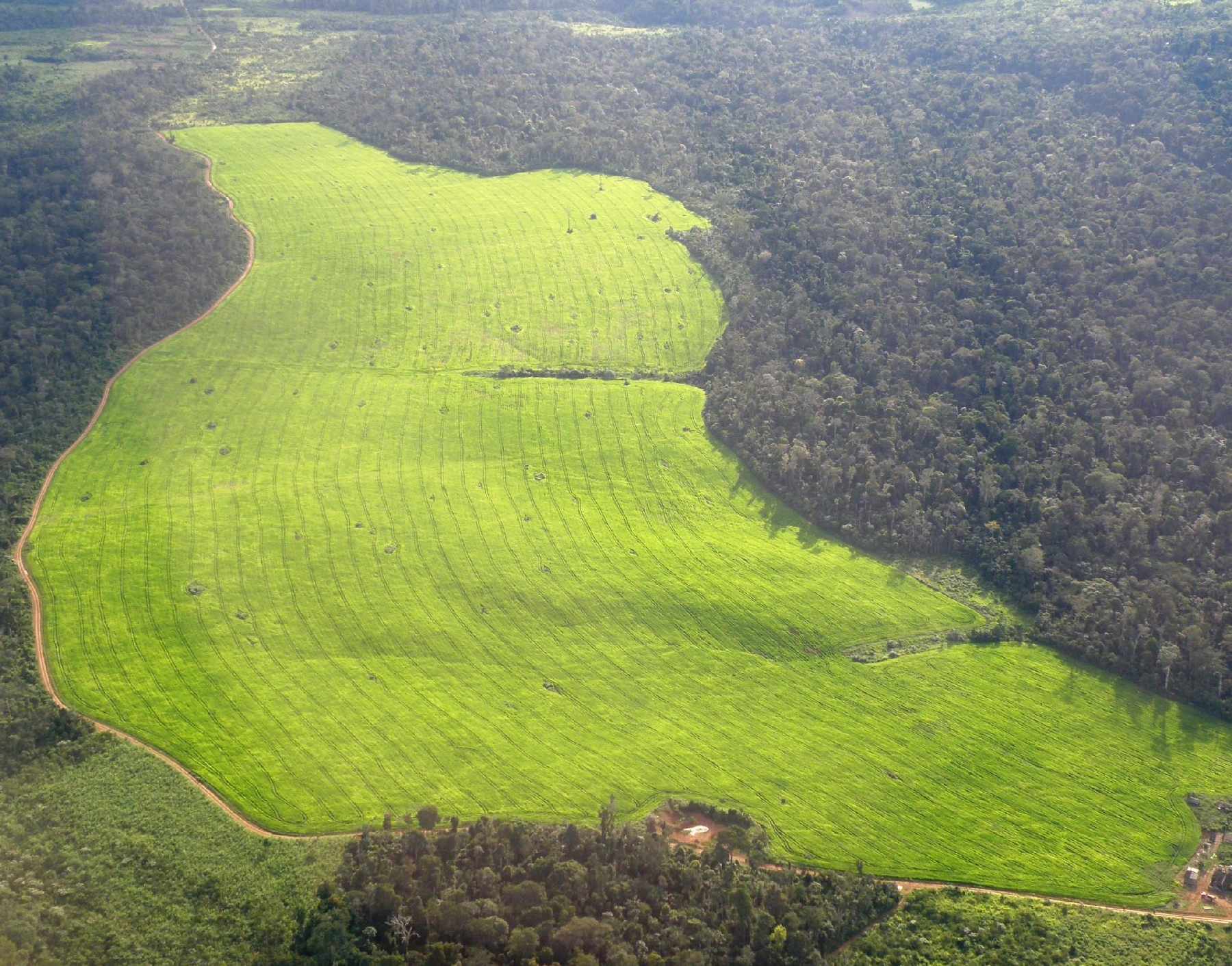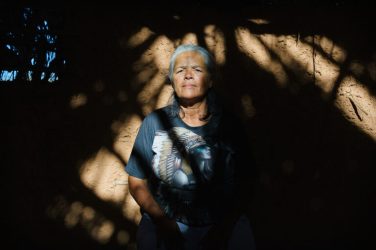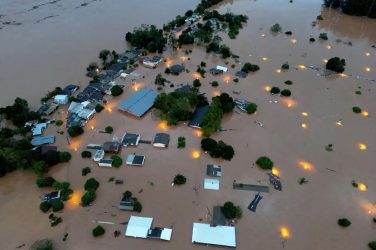Over the last 40 years, the north of the state of Mato Grosso has profoundly changed. This far-reaching transformation — matched almost nowhere else in the world — is largely due to the rapid expansion of industrial agribusiness, particularly soybean production, which has destroyed huge swathes of savanna and tropical Amazon rainforest.
“There are certain regions, near Brasnorte [to the west of Sinop], for example, where you can look completely around, 360 degrees, and not see a single tree,” says anthropologist Rinaldo Arruda, a lecturer at the Catholic University (PUC) in São Paulo.
There is much talk about the prosperity that agribusiness has brought to Mato Grosso state, but, according to Andreia Fanzeres, coordinator of the indigenous rights program at the NGO Opan (Operação Amazônia Nativa), the traditional communities, which had inhabited the region for centuries, were not consulted, nor have they benefited from the rise of soy:
“The indigenous communities and the family farmers, rural communities in general, were always outside the decision-making process as to what type of development they would have”.
Soybeans arrived in the state of Mato Grosso with startling speed: the area under its cultivation jumped from 1.2 million hectares (4,633 square miles) in 1991, to 6.2 million hectares (23,938 square miles) in 2010 and to 9.4 million hectares (36,293 square miles) in 2016.
According to Antônio Ioris, lecturer in human geography at the University of Cardiff, who has carried out research into the advance of agribusiness in Mato Grosso, the start of this growth period was heavily supported by the federal government’s agricultural research body, Embrapa:
“New technologies developed by Embrapa produced solutions for the acidic [nutrient-poor tropical] soils and other problems. The farming sector went through a crisis in the 1980s. Then soy arrived and ‘rescued’ it”.
The large-scale meteoric expansion of soy came at the end of the 1990s, when, Ioris says, “it benefited from both the [global] commodities boom and the liberalization of the [Brazilian] economy”.
Soy production is highly mechanized, and works most efficiently on very large plantations, so that led to the concentration of land ownership in Mato Grosso state among a small number of wealthy companies and individuals.
Then as commodities like soy boomed on the world market, the Brazilian economy became increasingly dependent on the millions of dollars brought in by soy exports.
Ioris explains: “This gave the [large-scale Mato Grosso] soy farmers enough political clout to demand the paving of the roads and the creation of further logistic support, including waterways.” He concludes: “Today agribusiness blackmails the country”.
Driving along the BR-163 highway through the largely depopulated Mato Grosso countryside, one sees evidence of the new bosses in the region — the multinationals, who sell the farmers their seeds and chemicals, and who buy the farmers’ produce.
Rising above a sea of soy are the occasional soybean silos, emblazoned with the logos of the multinational commodities companies that now control the region: Bunge, Archer Daniels Midland (ADM) and Cargill.
There are also silos belonging to Amaggi, a powerful Brazilian commodities player. The Amaggi company was built by André Maggi and is now run by his family, including his son, Blairo Maggi.
Once known as the “Soy King” and formerly the governor of Mato Grosso state, Blairo Maggi was chosen last year as Brazil’s agriculture minister by President Temer.
Maggi’s rise in influence has paralleled the rise in power of the bancada ruralista, the industrial agribusiness lobby that today holds sway over much of the National Congress.
After accumulating a fortune through planting, processing and exporting soy, Amaggi has now joined the big players on the international market, cultivating a particularly close relation with Bunge, with which it jointly owns grain terminals in Miritituba, the new commodities port on the lower Tapajós River.
The soy crop now flows by truck from north Mato Grosso down newly paved BR-163, to Miritituba, where the commodity is transferred to barges for the trip down the Tapajós to the Amazon River and on to foreign ports, especially in China.
Agribusiness as usual
Some credit soy production with bringing “modernity” and “development” to Mato Grosso. Aprosoja, the soy farmers’ trade association, speaks of “the positive socioeconomic impact of soy farming”.
It claims that for each person directly engaged in soy farming, another eleven jobs are created, “taking into account all the employment produced along the whole productive chain”.
Agriculture Minister Blairo Maggi, when he was a senator for Mato Grosso state in 2012, told the Folha de S. Paulo newspaper: “If it weren’t for soy, Mato Grosso would still be backward…. Today the soy farmer gets a 30 percent return on the capital he has invested.”
But for others, the 40-year soy expansion serves as just one more example in a long historical process in which the Brazilian rainforest has been cut down and rural indigenous and traditional populations disenfranchised — replaced by agribusiness monocultures owned by a very few who make the lion’s share of profit.
The sociologist José de Souza Martins, whose writings have become essential reading for Amazon scholars, showed that, while the military government in the 1970s spoke a great deal about attracting landless farmers to the Amazon (under the slogan “the land without people for the people without land”), powerful economic groups were the main beneficiaries of the money it poured into the region.
While the generals spoke of “occupying the empty land”, many large-scale landowners set up large cattle ranches that drove out many more people — including the “invisible” indigenous communities, rubber-tappers, and fisher folk — than they ever brought into the region.
Cândido Neto da Cunha, an agronomist employed by INCRA (the National Institute of Colonization and Agrarian Reform), believes that what is happening with soybeans now is, to a large extent, just a continuation of the military programs.
“Though ‘development’ has replaced ‘national security’ as the ideological driving force, the state is creating the same negative social consequences — rural exodus, deforestation and precarious labor conditions — through its support for agribusiness.”
Soy’s Playing Fields
In its march north, soy appears in some surprising places. One of these is at the Wesley Manoel dos Santos agrarian reform settlement, created by INCRA in 1977. Located 70 kilometers (43 miles) northwest of Sinop, this settlement exemplifies the serious challenges faced by Brazil’s small family farms.
The land was originally bought up by the Brazilian subsidiary of the German company, Mercedes Benz, at the end of the 1960s. According to research by Odimar João Peripolli, a lecturer at Mato Grosso State University, the company set up ten separate subsidiary companies to get around the legal limits on land ownership.
Each subsidiary bought “40,000, 50,000 or even 60,000 hectares, so that in the end it [Mercedes Benz] had acquired about 500,000 hectares (1.2 million acres). The whole large estate became known as Gleba Mercedes (the Mercedes Holding)”.
The company was able to use its clout as a large-scale landowner to gain hefty federal benefits, mostly tax rebates from SUDAM, the Amazônia development agency. This money was supposed to be invested into the land, but wasn’t, according to testimonies gathered by Peripolli.
The company’s vast holdings were “never, effectively, occupied by the company.” Mercedes eventually sold Gleba Mercedes to a São Paulo company, which in turn sold it to INCRA, which created an agrarian reform settlement with plots for 507 families.
But it’s not easy for a small-scale farm settlement to compete economically in a remote region where the government is actively promoting large-scale agribusiness. Lacking sufficient federal technical assistance, the settlement’s 500+ families tried several survival strategies.
In the beginning, they reared dairy cattle and sold milk and cheese in the town of Sinop. Though this was the nearest market, it still took three hours to transport dairy products there — and that was when it wasn’t raining.
The venture went well at first, but then ran into government obstacles. Settler Jair Marcelo da Silva, known as Capixaba, relates how the small-scale dairy farmers were very careful with hygiene, because it was their principle to only sell products that they themselves consumed.
However, their common-sense approach didn’t satisfy the authorities. “The food safety bodies don’t think like ordinary people, they think very differently”, says Capixaba.
The authorities made unrealistic regulatory demands on the small-scale farmers, and when they couldn’t satisfy those demands, the settlers were banned from selling their produce in Sinop. It was the end of their dreams.
“I had six cows, from which I took on an average 90 liters of milk a day”, explains Capixaba. “What was I supposed to do with this milk [if the federal authorities wouldn’t let me sell it]? What do you think? We gave it to the pigs! Just imagine that!”
The settlers tried rearing pigs and chickens, but once again they fell afoul of food safety regulators. Lacking any other income, some settlers trained to operate the sophisticated machines used by the large-scale farmers who had the money to comply with government health and safety rules. Others worked as day laborers. Women found jobs as maids in Sinop, leaving their husbands to look after the children.
In time, all attempts to use their land to earn a living were largely abandoned.
Soy Fills the Vacuum
Shortly, the vacant land of the agrarian reform settlement caught the eye of big soy farmers and the impoverished settlers began renting their plots for nothing, or almost nothing, to the soy producers.
In exchange the large-scale soy farmers “tamed the land.” This expression, frequently heard in the region, describes the slashing-and-burning of native vegetation, digging out of tree roots, and use of chemicals to reduce soil acidity — an expensive land-preparation process that takes at least three years.
And so, a poor settler got his cropland cleared of forest, something he couldn’t afford to do for himself, and, in a world where land stripped of native vegetation is worth much more than standing forest, the settler ended up with a more valuable asset. Though, of course, he didn’t end up with the soybean crop; those profits went to the large-scale farmers.
Soybeans have also arrived in the agrarian reform settlement by a more circuitous, less legal route. During our November 2016 visit, we noticed an enormous soybean plantation, much too big to belong to a single settler. Capixaba explained how it got there.
By law, all settlers must keep a portion of their land as forest and INCRA had decreed that it made more sense, from an ecological point of view, to bring all these forest lots together in a single collective reserve. Capixaba said that the forest in their reserve was “so dense that fire never penetrated it”.
But little-by-little the big soy farmers managed to penetrate it. Capixaba said that the soy farmers used the correntão — an enormous chain, 100 meters long, suspended between two huge tractors, which, when pulled along, knocks down all the forest in its path.
The illegally cleared 3,500 hectare (8,650 acre) area is now completely covered in soy. Nobody knows for sure how this all happened, but many settlers say that a corrupt INCRA employee ceded the forest reserve to the soy farmers and then bought himself a mansion in Barra do Garças, a city in the south of the state, with his unlawful profits.
Gleba Mercedes is not an isolated case. The criminal advance of agribusiness into agrarian reform settlements has happened elsewhere. For instance, the Terra Prometida Operation, launched by the Federal Police in November 2004, led to the arrest of more than 20 people in the Tapuráh-Itanhangá settlement to the west of Sinop.
According to police, the soy farmers had taken over more than 1,000 of the 1,149 settler plots, and had created a giant soy plantation. Among those arrested were Odair and Milton Geller, brothers of then Agriculture Minister, Neri Geller, who is currently the ministry’s Secretary for Agrarian Policy.
The geographer Antônio Loris sees little hope for the reform of large-scale agribusiness because he sees it as “intrinsically corrupt.” He asserts that “there is a very evident and immediate form of corruption (as in the way INCRA is controlled by landowners and land thieves), but there is also a long-term form of corruption, expressed in the violent appropriation of land, aggressiveness against squatters and Indians, and social and environmental destruction.”
Legitimizing Land Theft?
Under the Brazilian Constitution, a settler in an agrarian reform settlement cannot sell his land title for ten years. This meant, for example, that it was illegal for agribusiness to buy the plots in the Tapuráh-Itanhangá settlement because, although the settlement was created in 1997, almost all the beneficiaries had not held their plot titles for ten years.
However, in December 2016, the Temer administration issued a presidential decree (MP 759), which altered the situation. The decree largely dealt with the chaotic housing situation in the poor districts that have sprung up around most of Brazil’s large cities.
Because MP 759 will make it easier for some people to register their land ownership, it was welcomed by some lawyers, with one calling it President Temer’s “Christmas present”.
Bruno Araújo, Brazil’s Minister for Cities, said that, by allowing poor urban dwellers to get titles for their land, the decree will put “millions of assets into the economy”.
But, unnoticed by most observers, the decree also altered how the ten-year term is counted in agrarian reform settlements. Under the old system, the term only began once the structure of the settlement was in place and the settler had received his or her land title; now the counting starts when the family receives formal notification that it has been given a plot.
It may seem an unimportant bureaucratic adjustment but agronomist Cândido Neto da Cunha believes it to be highly significant: “MP 759 is clearly intended to legalize the illegal occupation of agrarian reform land and to put more of it on the market” quicker.
Cunha says the settlements don’t receive the support they need from the federal government and this weakens the settlers economically. “They become more vulnerable to pressure to sell their land in areas where agribusiness is expanding,” he explains.
The unchecked, ever-rising global demand for soy creates a bleak outlook for the Amazon rainforest and its indigenous and traditional communities.
The driving force behind the advance of soybeans in Brazilian territory is Chinese demand and policy. Up to 1995, China was self-sufficient in soybeans. But that year the country’s human population outpaced food crop production, and the government decided to prioritize crops.
It upped the in-country production of human foods — wheat, rice and corn — and reduced soy production — most of which is fed to animals. The motive was simple: the people and government still remembered the Great Famine of 1959-61 when millions starved to death, and so were fearful of relying on imported food.
The impact of the policy shift was immediate: by 2011, China was importing 56 million tons of soy. Since then, demand has gone on growing: China is expected to import 102 million tons this year and probably 180 million tons by 2024 — more than the combined current output of the world’s three largest growers (the US, Brazil and Argentina).
Where will this production come from? It is unlikely that the US can increase its production and analysts have been saying since 2010 that the area under soybean cultivation in Argentina cannot grow significantly. That leaves Brazil to fill the gap.
Until recently, Brazil significantly increased its soy output primarily through rises in per-acre productivity, but there seems little room for further improvements here. Since 2000, Brazil’s soy productivity has stabilized at about three tons per hectare.
The only option then for meeting China’s demands, argues Lester Brown, president of the Earth Policy Institute, is to push the agricultural frontier deeper into the Amazon forest.
That’s a goal also totally in keeping with the plans of the politically powerful ruralista agribusiness lobby, and by all legislative indications, of the current Brazilian government.
The anthropologist Rinaldo Arruda is deeply alarmed by the prospects of a 21st century soy invasion, deep into Amazônia’s heart. He envisions “cities swelled with people, without sanitation, very violent places, with internal conflicts and degraded environments.
“A shanty-town Amazônia. This notion that our society has, at least from the 19th century, of becoming more and more civilized is profoundly mistaken. It doesn’t exist. It’s a fiction.”
This article appeared originally on Mongabay – https://news.mongabay.com/














